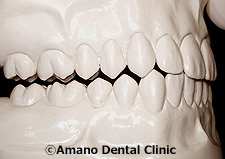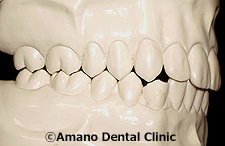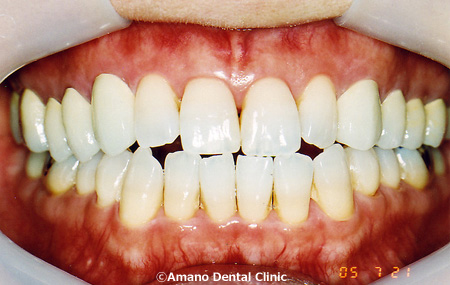
In general, the ideal bite may mean properly aligned teeth.Beautiful-looking teeth, however, do not always mean an ideal and stable occlusion.
Have you sought a dental consultation for an irregular toothache?You somewhat felt pain, but the toothache disappeared a couple ofdays later. X-rays or periodontal examinations do not reveal anyproblems. It could be caused by malocclusion. We often find a bad bite is the source of an irregular toothache, especially if the pain is in a back tooth. It is usually associated with cusps.
When chewing food, we unconsciously move the jaws not only up and down, but also right and left. When the jaw closes, all the teeth make full contact. When sliding the lower jaw to one side, only the upper and lower cusps in contact, leaving slight space between the upper and lower back teeth. This is called “cuspid guidance” occlusion.
The back teeth are formed to withstand pressure, but not lateral movement. Cusps have long roots and are very strong. In the ideal occlusion, only the cusps are used and the back teeth are left unengaged when the jaw moves to the side. Improper alignment, cavities or grinding teeth may result in losing the ideal occlusion. When the back teeth start to receive lateral pressure, many problems could also start to occur, including sensitiveness, cavities, cracks, shifts, gingivitis and even TMJ.

This photograph shows occlusion when the upper teeth are simply lying on the lower teeth, which is called maximum intercuspation. In this position, the upper cusps are fully interposition the lower cusps, and both cusps are locked in. It may look perfect to chew food, but it is not the ideal position. In order to grind food, the lower jaw must be able to move to the side.


The second photograph shows occlusion after moving the lower jaw to the right direction, which is called lateral excursions. All the back teeth, except the cusps (the fifth tooth from the left) are not engaged. This is the ideal occlusion, cuspid guidance.
The third photograph is the occlusion without cuspid guidance. Because the lower cusp is cracked, the four back teeth received the entire pressure from lateral excursions of the jaw. This may cause various problems to the back teeth.

This patient complains about jaw clicking and pain. We found that the upper and lower front teeth did not close together, and there was no cuspid guidance. The lower jaw was unstable and shifted to the left.

All the upper back teeth and cusp were replaced with GES crowns. The entire occlusion was brought down so that the upper and lower front teeth could touch each other. The jaw became in place by correcting occlusion.
The lower jaw was also realigned. The jaw clicking and pain disappeared. The front teeth, which were not replaced with GES crowns, were whitened using Home Bleaching program. The result is a beautiful smile.